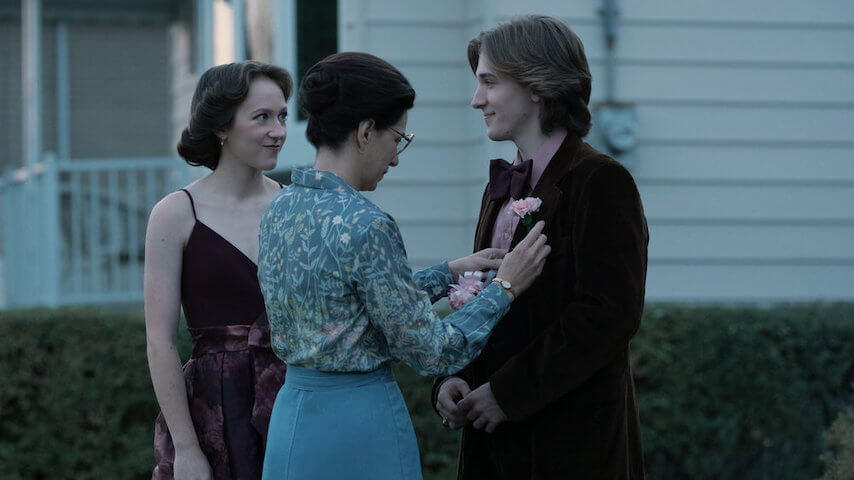Watching Peacock’s Devil In Disguise: John Wayne Gacy won’t tell you much more about the Illinois serial killer than you could have already gleaned from the countless documentaries and other renderings of his life over the years. But one thing has changed: Now you can name a dozen or so of his 33-plus victims and know a little bit about the lives they led separate from the man who robbed them of a future.
A victim-forward story shouldn’t be a rarity in the day and age of true-crime series clogging streamers, but it too often is. Recent docuseries like One Night In Idaho and Gone Girls: The Long Island Serial Killer prioritize foregrounding the lives lost at the hands of bad men, but dramatic adaptations tend to lean into the sensational to stand out. Watching Devil In Disguise is a harrowing experience, but frankly, it is also jarringly moving. The eight-episode series from showrunner Patrick Macmanus (Dr. Death) that stars Michael Chernus (Severance) doesn’t chart a linear path through Gacy’s upbringing, killing years, and downfall as so many true-crime dramas are wont to do. Instead, it starts at his end, when his final kill seals his fate, and then dips back in time to show a sampling of the lives he stole along the way. Each episode is named for one or more of those boys. (His youngest victim was 14, and his oldest were 21.) These were kids still getting a grip on life, as seen through the snapshot portraits of just a few of them. By giving us the life instead of the death, our minds aren’t left with the end but rather what could have been.
But most surprisingly, in this moment when even true-crime obsessives are a bit desensitized to the string of series adapting serial-murder stories, Devil in Disguise almost entirely avoids depicting the horrific kidnappings, rapes, tortures, beatings, and murders of Gacy. By largely steering clear of the violence, the series presents something even more chilling and unsettling. It doesn’t glorify Gacy’s methods or madness, but rather makes the audience sit with the all-too-brief potential of the people he killed. Watching 19-year-old petty grifter Billy Kindred (Coltan Ryan) excitedly tell his fiancée that he might have landed a real job with a local contractor is instantly tainted by the grim knowledge the man on the other side of that opportunity is Gacy. Without even uttering his name, Billy’s excited phone call as he heads over to this guy’s house to sign some papers makes you hold your breath. Knowing the fate of so many who fell for the same trap, the sound of his unbridled hope about maybe, possibly, finally finding a legitimate means of providing for the life and the love he always wanted, rings in your ears like the dropping of an anvil.
Often without a single drop of blood, Macmanus and his creative team manage to illustrate the real tragedy within the crime: the immense loss of life and light. That makes Devil In Disguise an even tougher, heavier watch than most shows like it. But it also feels more worthy of your attention in that respect and especially in comparison to other series that adapt real-life serial killings with an intention to turn our stomachs rather than actually make a real point about its subject. No bucket of blood or tapestry of human flesh can touch the sickening feeling of seeing Gacy’s final victim, 15-year-old Robert Piest (Ryker Baloun), come to terms in real time with the fact that the initially kind man offering him a job has lured him into something more dangerous. There’s a tremble in his voice as Gacy tricks him into putting on handcuffs and then threatens to rape him because he won’t give into his sexual advances. When Gacy momentarily snaps out of his fury, his young captive is the one who heartbreakingly apologizes because he’s a kid who thinks he somehow led the grown man on—and even promises to still work for him out of innocent obligation while he is pulling up his pants with the belief he will leave unscathed after all. He doesn’t, of course, and watching the realization of his fate wash over his face when Gacy returns with a hammer will burrow its way into your mind.
There’s also 19-year-old Johnny Syzc (Levi Shelton), who enjoys his first joyous night out as a queer man painted in his best David Bowie makeup. He dances with his friend, kisses a boy, and lives out loud. Even when his mom finds him washing his face at home, she doesn’t scold him or cast him out, but rather swallows her conflicted feelings and hands him the best cream to remove it. His story ends with him going to prom giggling with and grasping onto that pal as they step into the next chapter of their lives, one she will ultimately take alone.
And then there’s Frank “Dale” Landingin (Brayden Raqueño), a young man in an abusive home who turns to a life of hustling with his new friend William “Billy” Carroll Jr. (Max Mattern), both of whom will die at Gacy’s hands. Their budding bond, even set against the dicey backdrop of sex work in the 1970s, has a tenderness to it as they watch each other’s backs when picking up johns until one of them goes missing. Dale finding a community, even though it is out of reach from his best friend Phil (Igby Rigney), gives you a fleeting comfort that he wasn’t alone in his life when it was cut short. But the hunt for a silver lining is always shuttered when the series returns to the prolonged excavation of the crawl space where Gacy buried most of his victims (others, like Piest, were thrown in the river) and reminds us that these otherwise disparate lives all ended in the same place.
The show doesn’t let the man in the clown makeup steer the narrative, as seen in the final two episodes’ focus on a pair of survivors. David Cram (Jake Horowitz), who rented a room from Gacy, was unknowingly paid to dig the crawl space that would become a cemetery and repeatedly raped. Jeffrey Rignall (Augustus Prew) was held hostage by Gacy and also raped and tortured with lit candles to the face—all of which he reported to the police to no avail (a systematic failure the series homes in on as well). The mere sight of Jeffrey’s blistered face as he flees for his life is enough without needing to recreate the worst moment of his life for the audience. Similarly, David’s experiences with Gacy aren’t represented by a montage of the many ways he was taken advantage of and assaulted, but rather by a lengthy scene where he is made to watch an increasingly sexual and disturbing puppet show. In that sequence, Gacy’s face is never even seen. There’s just the haunting tone of his voice as he plays out his demented scheme from behind his cardboard stage.
The final episode follows a similar mandate to show Gacy as little as possible onscreen. You hear him. You feel his presence. You watch him walk naked into the life of another unsuspecting boy who didn’t see the threat of him coming. But in the end, Devil In Disguise is confident enough to know that you don’t need to watch what Gacy did to know what he took. Instead, it cedes the floor to the boys whose lives are too often summed up under the word “victim.” It focuses on the life before all the death because we already know what happened. Besides, television has shown us the act of murder so often that our minds are perfectly and horrifyingly capable of filling in the blanks.









































